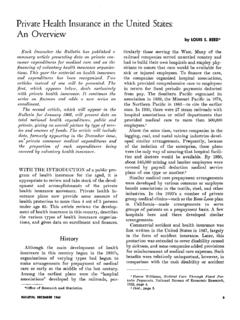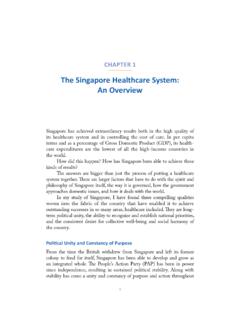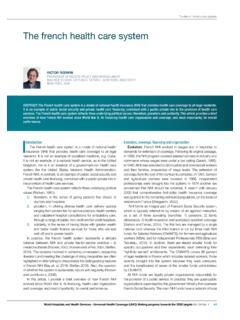Transcription of Economic Impact of Infrastructure Investment
1 Economic Impact of Infrastructure Investment Jeffrey M. Stupak Analyst in Macroeconomic Policy January 24, 2018 Congressional Research Service 7-5700 R44896 Economic Impact of Infrastructure Investment Congressional Research Service Summary Infrastructure Investment has received renewed interest as of late, with both President Trump and some Members of Congress discussing the benefits of such spending. Infrastructure can be defined in a number of ways depending on the policy discussion; in general, however, the term refers to longer-lived, capital-intensive systems and facilities, such as roads, bridges, and water treatment facilities.
2 Over the past several decades, government Investment in Infrastructure as a percentage of gross domestic product (GDP) has declined. Annual Infrastructure Investment by federal, state, and local governments peaked in the late 1930s, at about of GDP, and since has fallen to about of GDP in 2016. State and local governments consistently spend more on Infrastructure directly than the federal government . In 2016, direct federal spending on nondefense Infrastructure was less than of GDP, whereas state and local spending was about of GDP. However, the federal government transfers some funds each year to state and local governments for capital projects, which includes Infrastructure projects, equaling about of GDP in 2016.
3 The United States also lags many other developed countries with respect to annual Infrastructure spending. Spending on Infrastructure , as a percentage of GDP, is higher in all G7 countries, except for Italy and Germany, than in the United States. Infrastructure is understood to be a critical factor in the health and wealth of a country, enabling private businesses and individuals to produce goods and services more efficiently. With respect to overall Economic output, increased Infrastructure spending by the government is generally expected to result in higher Economic output in the short term by stimulating demand and in the long term by increasing overall productivity.
4 The short-term Impact on Economic output largely depends on the type of financing (whether deficit financed or deficit neutral) and the state of the economy (whether in a recession or expansion). The long-term Impact on Economic output is also affected by the method of financing, due to the potential for crowding out of private Investment when investments are deficit financed. The type of Infrastructure is also expected to affect the Impact on Economic output. Investments in core Infrastructure , defined as roads, railways, airports, and utilities, are expected to produce larger gains in Economic output than investments in some broader types of Infrastructure , such as hospitals, schools, and other public buildings.
5 Changes in Economic output are expected to have subsequent effects on employment; as such, Infrastructure investments are likely to Impact employment as well. Recent research suggests modest reductions in the unemployment rate in response to increased Infrastructure Investment . Again, it is expected that the method of financing and state of the economy will alter these impacts. Recent research has suggested that deficit-neutral investments are less likely to affect employment, whereas deficit-financed investments are expected to reduce unemployment in the short term. Additionally, recent Economic research suggests that during an Economic expansion, with a relatively strong labor market, Infrastructure investments are unlikely to have any sustained Impact on the unemployment rate.
6 However, during a recession, the same Investment is likely to reduce the unemployment rate to some degree, research suggests. Economic Impact of Infrastructure Investment Congressional Research Service Contents What Is Infrastructure ? .. 1 Infrastructure Investment Trends .. 1 Infrastructure Investment in the United States .. 2 International Comparisons .. 8 The Economy and Infrastructure Investment .. 8 Effects on Economic Output .. 9 Financing .. 9 Business Cycle Timing .. 12 Type of Infrastructure .. 13 Employment Effects .. 13 Financing .. 14 Business Cycle Timing .. 15 Concluding Thoughts .. 15 Figures Figure 1.
7 Annual government Nondefense Investment in Public Capital, 1929-2016 .. 3 Figure 2. Annual Federal Nondefense Investment , 1929-2016 .. 4 Figure 3. Federal Nondefense Investment by Budget Function, 2012 .. 5 Figure 4. Annual State and Local Investment , 1947-2016 .. 6 Figure 5. Cumulative Stock of Nondefense Federal Capital, 1929-2016 .. 7 Figure 6. Cumulative Stock of State and Local Capital, 1929-2016 .. 7 Figure 7. Transportation Infrastructure Investment in G7 Countries, 2014 .. 8 Contacts Author Contact Information .. 16 Economic Impact of Infrastructure Investment Congressional Research Service 1 nfrastructure Investment has received renewed interest as of late, with both President Trump and some Members of Congress discussing the benefits of such spending.
8 The condition and performance of Infrastructure is thought to affect the Economic well-being of countries in a number of ways. This report provides an overview of the trends surrounding Infrastructure Investment in the United States and examines the potential Impact of additional Infrastructure investments on Economic output and employment. What Is Infrastructure ?1 Although Infrastructure spending has garnered increased attention recently, there is no generally agreed-upon definition of Infrastructure . In general, the term refers to longer-lived, capital-intensive systems and facilities. Some restrict the definition to include systems and facilities that have traditionally been provided by the public sector, such as highways and water treatment facilities.
9 However, others include predominantly privately owned systems and facilities, such as those involved in electricity production and distribution. The definition of Infrastructure can be extended even further to include research and development expenditures, as they add to the stock of technology and information available for use by private individuals. Infrastructure is beneficial for both businesses and households and for the economy broadly. For businesses, Infrastructure can help to lower fixed costs of production, especially transportation costs, which are often a central determinant of where businesses are For households, a wide variety of final goods and services are provided through Infrastructure services, such as water, energy, and Infrastructure benefits the economy overall, as it allows more goods and services to be produced with the same level of inputs, fostering long-term Economic growth.
10 Federal, state, and local governments share the cost of Infrastructure investments, with the majority of direct spending coming from state and local governments. The federal government contributes to Infrastructure investments in the form of direct spending, grants to state and local governments, loan guarantees, and preferential tax treatment. Infrastructure Investment Trends Due to the ambiguous definition of Infrastructure , tracking government spending on Infrastructure investments can often be difficult. One of the more comprehensive sources of data on government Investment in Infrastructure is the Bureau of Economic Analysis (BEA), which tracks government spending and Investment in various government spending is divided into consumption expenditures and Consumption expenditures consist of spending by the government 1 This section has been adapted from CRS In Focus IF10592, Infrastructure Investment and the Federal government , by William J.













